Little Wishlist: Insights into Baby Nightmares - Tips & Solutions
With Halloween just around the corner, we collaborated with child health experts, Kemi Omijeh (child and adolescent therapist) and Dr. Hana Patel (mental health coach and GP) to discuss nightmares and night terrors.
We'll cover the key differences, causes, common themes in nightmares, tips and solutions, and when to seek further medical advice.
Read on to find out more…
Nightmares vs. night terrors
Nightmares are pretty common; a lot of us have them. Nightmares affect both adults and children, and we can wake up from a nightmare and usually remember what happened, and most people can move on relatively easily from a nightmare and get on with their day.
Conversely, night terrors are quite frightening and disturbing for the individual who experiences them. They are a sleep disorder accompanied by physical symptoms like heart racing, sweating, breathing fast, and looking like they are awake with eyes wide open. Night terrors tend to affect children from 3- 8 years old, and children who experience them rarely remember them, nor can they tell you the details of their night terror.
Causes
Dreams (including nightmares) are often a way for children to process their emotions, thoughts, and events that have happened to them – they often reveal what the child has been anxious or stressed about.
Nightmares are common and expected in children, and causes can range from when the child is experiencing a significant change or transition to feeling overwhelmed or may have been influenced by something they have seen or watched. Common causes include: watching something frightening, like a TV programme or a film; being worried, stressed, or anxious; some medication; mental health conditions, such as PTSD; being tired; being unwell; something that interrupts deep sleep, such as needing to go to the toilet or a loud noise.
Something significant would have to be going on for the child to be experiencing night terrors. Persistent lack of sleep is one of the most common causes, other causes include anxiety, traumatic events, and changes in the child’s life that cause distress.

Common nightmares
Children have fantastic imaginations. Their dreams, like their play, can be incredibly creative and imaginative and feel very real to them. Nightmares often correspond with the child’s developmental age. Common nightmares for children include dreaming about:
- Monsters - usually suggest that you are facing mental and emotional distress in your waking life
- Drowning - usually suggests that you are feeling overwhelmed or might even represent control issues
- Getting lost or losing something important - usually suggests that you are anxious about something
- Being chased - usually suggests that you are anxious about something or experiencing heightened or ongoing stress
- Feeling trapped - usually suggests that you are caught in a difficult, restrictive, or even dangerous situation
- Natural disasters - usually suggest that you are nervous about a big change related to feelings of security or the plans, goals, and hopes you had for the immediate future
- Public humiliation/catastrophe (things going wrong for them publicly) - Usually suggests that you have feelings about being exposed as ill-prepared, incompetent, or deserving of shame
- Teeth falling out - usually suggests that you are feeling a loss of control or are worried about losing something or someone important to you
Halloween can trigger a child to have nightmares, particularly for those with an active imagination… As there are scary images and noises associated with Halloween, these can affect their sleep due to creating (or heightening) a fear of the dark, monsters, being trapped, or not wanting to go to bed.
With this in mind, be sure to review any planned Halloween activities for age- (and child-specific) appropriateness.
Tips and solutions
Supporting children with nightmares and night terrors are two different approaches.
With nightmares, they need both their emotions and body regulated immediately after they wake. Offer them a soothing touch and a glass of water, and encourage them to take deep, slow breaths.
After, allow them to talk through their dream at their pace if they wish. Offer them reassurance and validate their feelings. With nightmares, create opportunities for children to come to you and express their thoughts and feelings. Join in their toy play and use the toys as a safe way for them to explore the nightmares. Allow children to ask you questions to deepen their understanding.
When it comes to night terrors, these happen during the early part of the night, and some children have more than 1-night terror episode each night, lasting up to 15 minutes at a time.
During a night terror, it can be difficult to calm a child down, but try to stay calm and do not try to wake the child up, as they will be disorientated, and they may not recognise you and get more upset. Unless the child is at risk of hurting themselves, the NHS advises that we do not try to stop them from moving around and wait until they have calmed down.
For some children, night terrors occur at the same time each night, and you may be able to stop them from happening by waking them up 15-20 minutes before. Also, having a consistent and relaxing bedtime routine can help reduce night terrors – this should take between 30 to 60 minutes. Incorporating a comforting smell into the routine would also be great.
Once they are awake, address things that are causing the child’s stress and support them to process their feelings and express them. Just to break it down in language that the child understands. When it comes to console your child, validate their feelings, use soothing tones, remind them they are loved and safe, and help them regulate their body with breathing exercises and cuddles.
Also, ensure that they sleep enough, have a routine bedtime routine that is relaxing, and feel safe and comforted. To ensure they have an undisturbed sleep, be strict about screens and electronics at bedtime.

Limit screen time before bedtime
Seeking further medical advice
Consider medical advice or treatment for your children’s nightmares or night terrors if they are persistent and happening over a significant period. Or if either dreams or night terror are impacting their life and their ability to enjoy their day and thrive.
Night terrors are likely to need support from a professional – seek specialist support or therapy for the child experiencing frequent night terrors.
If they are afraid to sleep, hurt themselves, or the night terrors seem to be increasing or becoming more frequent, and you’ve tried the things above, talk to your GP for further advice. Sometimes medical conditions can stop children from sleeping well and make them more likely to have night terrors or nightmares, such as enlarged tonsils.
Some children might have a condition called 'sleep paralysis', where you are unable to move or speak as you fall asleep and different from a night terror and can be frightening. If your child is experiencing this, also seek additional medical advice.
---
*Expert advice correct as of September 2022



















